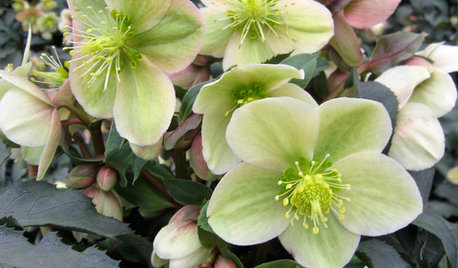Hellebore Black Death
bruceNH
21 years ago
Related Stories

WINTER GARDENINGGreat Design Plant: Gold Collection Hellebores Perform Like Stars
Exciting colors, longer bloom times, forward-facing flowers ... These hybrids leave old hellebores in the dust
Full Story
BLACKColor Guide: How to Work With Black
Take a walk on the dark side — your home has nothing to fear with this color when you know how to use it
Full Story
COLOREvery Room Needs a Little Bit of Black
‘I’ve been 40 years discovering that the queen of all colors was black.’ — Pierre-Auguste Renoir
Full Story
BLACKThe Case for Beautiful Black Doors
To-do list: Freshen up the house with crisp black doors, inside and out
Full Story
MOST POPULAR11 Reasons to Paint Your Interior Doors Black
Brush on some ebony paint and turn a dull doorway into a model of drop-dead sophistication
Full Story
PINKThe Pink Link — Learn the Secrets of a Decorating Darling
Is it the kiss of death for masculine rooms? Can it soothe a psyche? Discover the history and theories behind this delightful color
Full Story
PRODUCT PICKSGuest Picks: 20 Art Prints Under $100
Create or add to your gallery display with affordable black-and-white and neutral prints
Full Story
KITCHEN DESIGN5 Favorite Granites for Gorgeous Kitchen Countertops
See granite types from white to black in action, and learn which cabinet finishes and fixture materials pair best with each
Full Story
GLAM STYLEGoth Glamour for Halloween and Beyond
It's creepy and it's kooky, mysterious and ... well, you know. But gothic style around the home can also be strikingly elegant
Full Story
MODERN ARCHITECTUREKeep Your Big Windows — and Save Birds Too
Reduce bird strikes on windows with everything from architectural solutions to a new high-tech glass from Germany
Full Story





bruceNHOriginal Author
bruceNHOriginal Author
Related Professionals
Forest Park Landscape Architects & Landscape Designers · Horsham Landscape Architects & Landscape Designers · Richmond Heights Landscape Architects & Landscape Designers · Wheeling Landscape Architects & Landscape Designers · Waterbury Landscape Contractors · Brooklyn Park Landscape Contractors · Farmington Landscape Contractors · Gainesville Landscape Contractors · Gallatin Landscape Contractors · Hannibal Landscape Contractors · Mahwah Landscape Contractors · Pahrump Landscape Contractors · Whittier Landscape Contractors · Woodland Landscape Contractors · Waterville Siding & ExteriorsbruceNHOriginal Author
bruceNHOriginal Author
bruceNHOriginal Author
goswimmin
zone5rose
morz8 - Washington Coast
pansgardener_waz7
bruceNHOriginal Author
marniek
hellebore